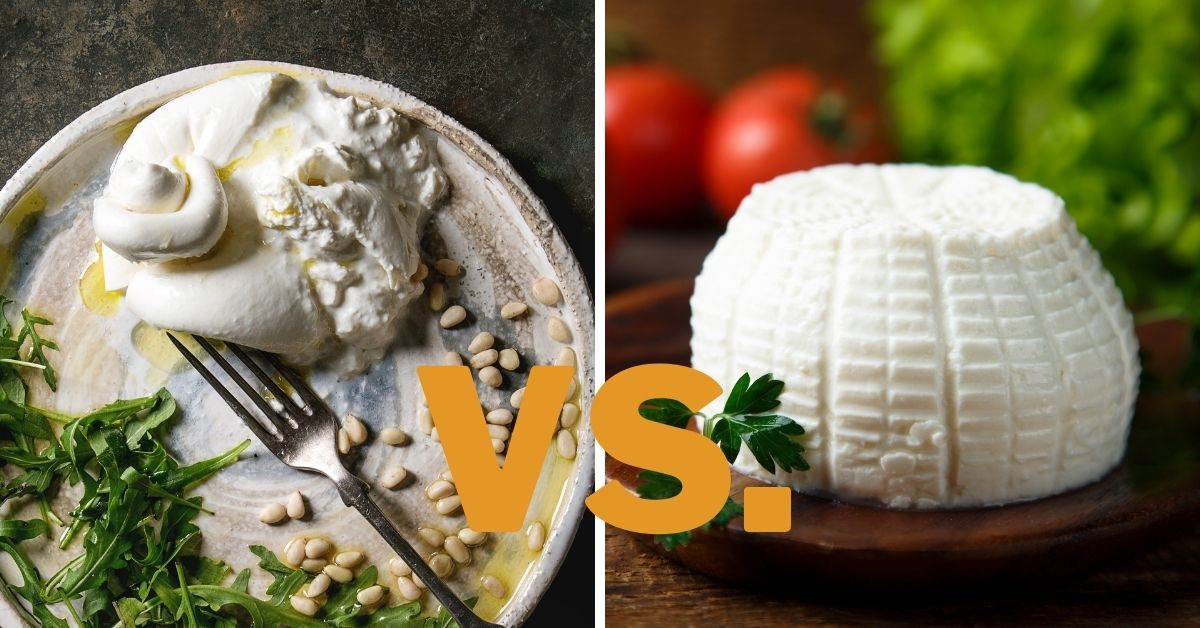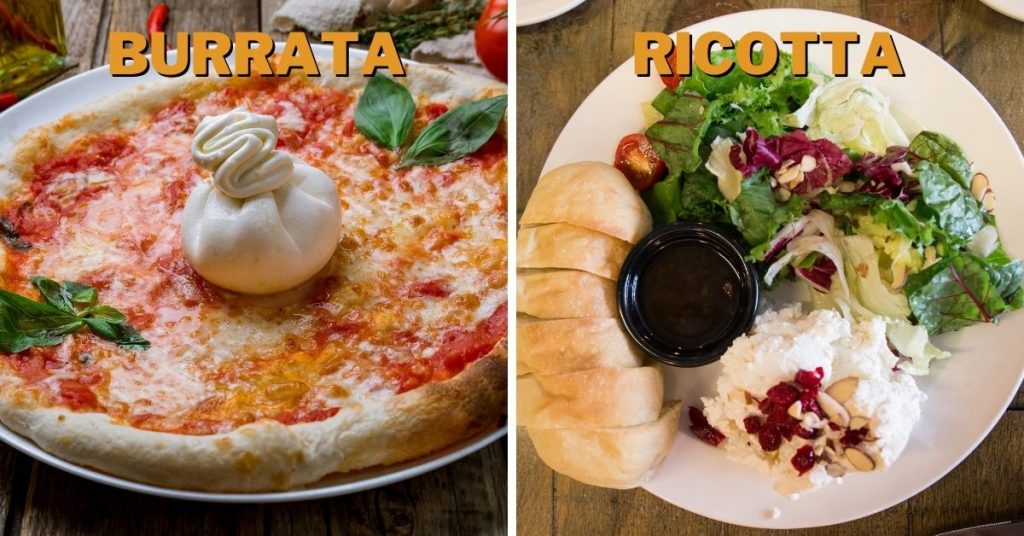Burrata vs. Ricotta: Differences & Which One to Use?

With so many options to choose from, picking the right cheese can get surprisingly frustrating. Each cheese brings its own taste, texture, color, not to mention the different prices. Among this diverse catalog, burrata and ricotta share some similarities. But, what are the actual differences between burrata and ricotta?
Burrata is made by using mozzarella and cream, whereas ricotta is made from the leftover whey from other cheese production. Burrata has a rich and creamy texture due to its curd and cream-filled center. It is used for pizza and salads. In contrast, ricotta is fluffier and softer and used in desserts or pasta dishes.
Knowing how each cheese behaves and tastes can help you pick the right one for a particular dish. So, let’s take a closer look at the features of both ricotta and burrata, how they differ from each other and how you best utilize them in the kitchen.
Burrata vs. Ricotta: What Are Their Differences?
Both burrata and ricotta come from the land of Italy. While they can be made from a wide range of animal milk, today, both of them are mainly sourced from cow’s milk. Despite the similarities in origin and raw material, burrata and ricotta cheese differ from each other in many significant ways.
Preparation
Ricotta cheese is unique in that its manufacturing process is different from other popular cheeses. See, when you make cheese from milk, you need to add a chemical agent that will cause the milk to curdle, i.e. separate the solid from the liquid. The solid portion is called curd, and it is the part that most cheeses come from.
The remaining liquid is what we call “whey” which also contains milk solids but is not as congested. Now, this leftover liquid has many uses, including making ricotta cheese.
Cheesemakers will add some whole milk and an acidic agent (vinegar or citrus juice) to the remaining whey. Then they will heat the entire mixture, causing the residual curds to coalesce into a large lump. They then pour the vat onto a cheesecloth and strain all of the liquid out of it. Now, you are left with white, fluffy ricotta cheese.
Burrata, on the other hand, has a more typical making process. Making burrata is strikingly similar to making mozzarella, with a few key differences. Cow milk is often the dairy of choice, but buffalo milk is also common.
First, the cheesemakers will add rennet, a curdling enzyme, to heated milk in a large vat. The enzyme does its work and separates the milk into curd whey. They will then separate the curd and drown it in hot whey where the curd will form a pliable paste.
The cheesemaker will then start to knead and pull the paste into a stretchy, string-like consistency. The resemblance to pasta noodles is why this form is called “pasta filata.” Finally, the craftsmen mold the cheese into a small pouch and fill it with a mixture of fresh mozzarella and cream.
Taste and Texture
Ricotta has a mildly creamy and milky flavor with a light, fluffy, texture. It feels like a sponge cake on the palate. Of course, how creamy the cheese will feel depends on the fat content.
Burrata has an even creamier and richer flavor profile, thanks to the addition of a cream and curd filling. That cream and curd filling makes the taste of burrata truly stand out among most other cheeses.
Compared to ricotta, burrata has a thicker and creamier texture. Whereas ricotta feels like a sponge, burrata has an elastic bounce to it.
Appearance
Ricotta has a milky white, almost grainy appearance. You can clearly see how the milk solids have curdled together. In this form, ricotta bears some resemblance to cottage cheese.
In sharp contrast, burrata has a smooth and glossy look on the outside. From the surface, burrata resembles freshly made pizza dough. Once you cut it open, the stretched cheese and cream filling will come out, making it look like some sort of dumpling.

Nutrition
To get a better idea of the nutritional value of these two types of cheese, let’s put them side by side. For this comparison, we have taken a sample size of 100 grams each.
| Nutrition | Ricotta | Burrata |
|---|---|---|
| Calories | 150 Kcal | 214 kcal |
| Carbohydrates | 7.3 g | 3.6 g |
| Sugars | 1% | 4% |
| Total Fat | 10.2 g | 17.9 g |
| Saturated Fat | 32% | 14 g |
| Protein | 7.5 g | 14.3 g |
| Sodium | 110 mg | 286 mg |
| Potassium | 219 mg | 75 mg |
| Calcium | 206 mg | 286 mg |
| Retinol (vit A) | 120 mcg | 180 mcg |
| Cholesterol | 49 mg | 54 mg |
From this data, we can see that burrata cheese has almost double the amount of cholesterol and calories per 100 g compared to ricotta. This is something you have to keep in mind if you are monitoring your calorie input. [1] [2]
On the other hand, burrata is also a better source of calcium and sodium. It also contains more than twice the amount of protein as ricotta. This is because burrata cheese incorporates more of the milk protein and fat, while ricotta mainly has the leftover whey protein.
Use
Ricotta has a fluffy and soft texture, making it an ideal companion for pasta dishes. You can also grate some over a pizza or lasagna dish.
A ball of burrata is like a cheese ball that is filled with more cheese as well as cream. If the cheese is fresh and at room temperature, the filling will come oozing out the moment you cut into it. You can utilize the feature of burrata cheese and use it as a topping for your salad or salsa. You can also enjoy it with some crackers or bread.
The creaminess of burrata cheese makes it one of the best cheeses to use in a dessert or a sweet dish. Ricotta cheese is much more suited to savory dishes.
| Ricotta | Burrata |
|---|---|
| Lasagna | Pizza |
| Dessert | Mac & Cheese |
| Sauces | Salad |
| Stuffed Meat | Sandwich |
Of course, you can use whichever cheese that your palate prefers in the dish.
What Cheese Is Similar to Ricotta?
Cottage cheese is very similar to ricotta cheese, as both of them are very light and fluffy. Cottage cheese is low in calories and its flavor profile also matches up with ricotta. However, cottage cheese is noticeably less creamy than ricotta, a distinction to keep in mind when you are substituting one for the other in a dish.
What Cheese Is Similar to Burrata?
In terms of preparation and taste, mozzarella is the closest cheese to burrata. However, you will not receive the same contrast in texture with mozzarella or any cheese for that matter as you would burrata. Burrata is also creamier and richer than mozzarella.
But if you do not have burrata cheese at your disposal, then replacing it with mozzarella would be the ideal choice.
Can You Use Ricotta Instead of Burrata?
Though ricotta and burrata have highly contrasting texture profiles, they do share similarities in terms of flavor. Burrata does taste akin to full-fat ricotta cheese, though burrata is slightly creamier thanks to that filling. The exterior of the burrata is more elastic than the fluffy consistency of the ricotta.
So, you can use ricotta instead of burrata in a dish to get that creamy flavor. But you will not be able to recreate the same texture or effect.
Burrata vs. Ricotta: Which One Is Better?
If you are looking for a burst of creaminess and texture in a dish, it is hard to beat fresh burrata cheese. The visual appeal of fresh burrata, oozing on top of pizza or a salad is also noteworthy. Burrata cheese is a more aesthetically pleasing cheese.
But if you are looking for a cheese that is light and soft, without compromising on the creaminess too much, ricotta is your go-to. Plus, ricotta is significantly lower in calories and cholesterol. So, it is the better choice in a low-calorie diet.
To conclude, over the centuries, Italian cuisine has gifted us an amazing selection of cheese. And no doubt ricotta and burrata sit among that list near the top. Whichever of the two kinds of cheese you end up using, you are bound for a rich and creamy time.
